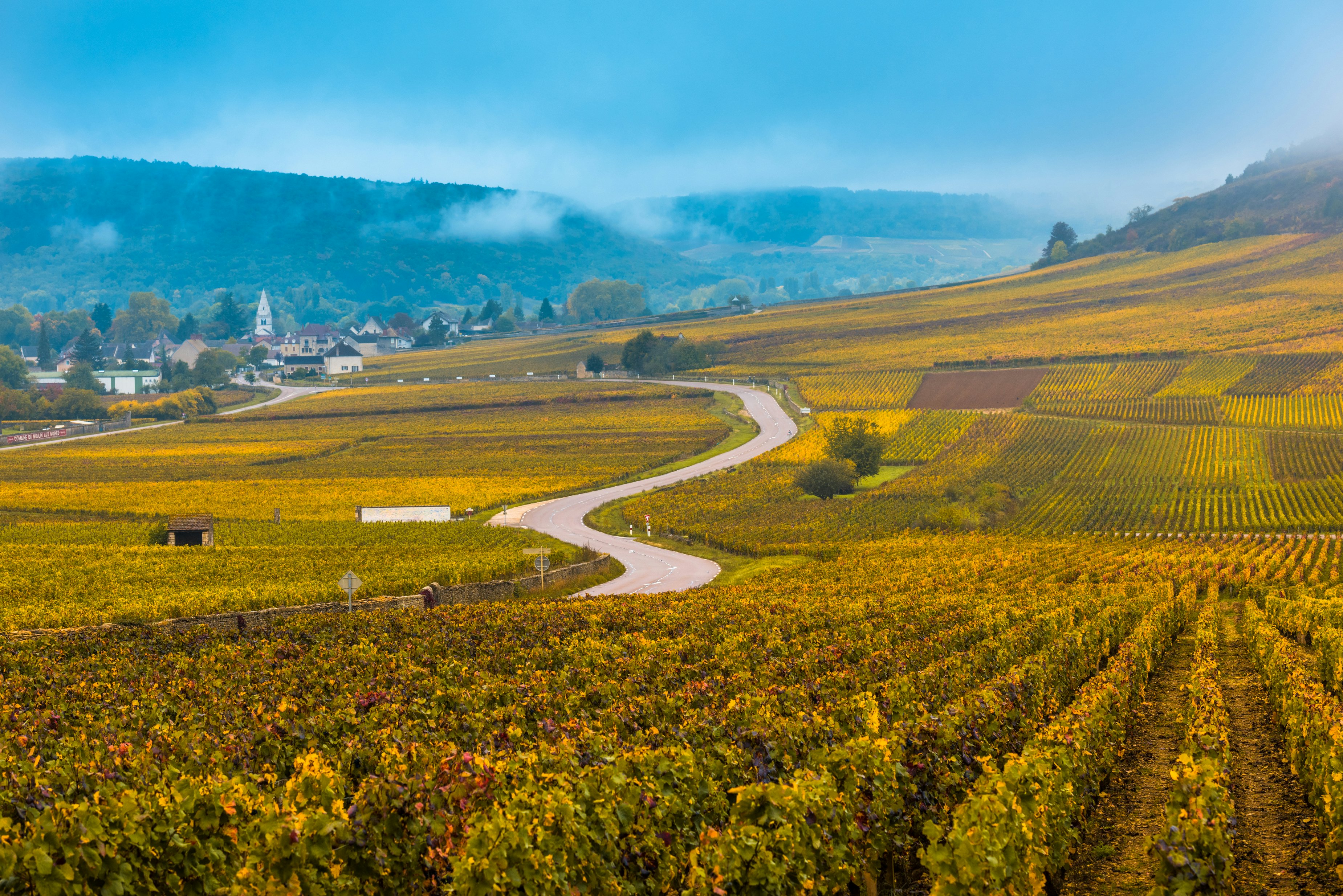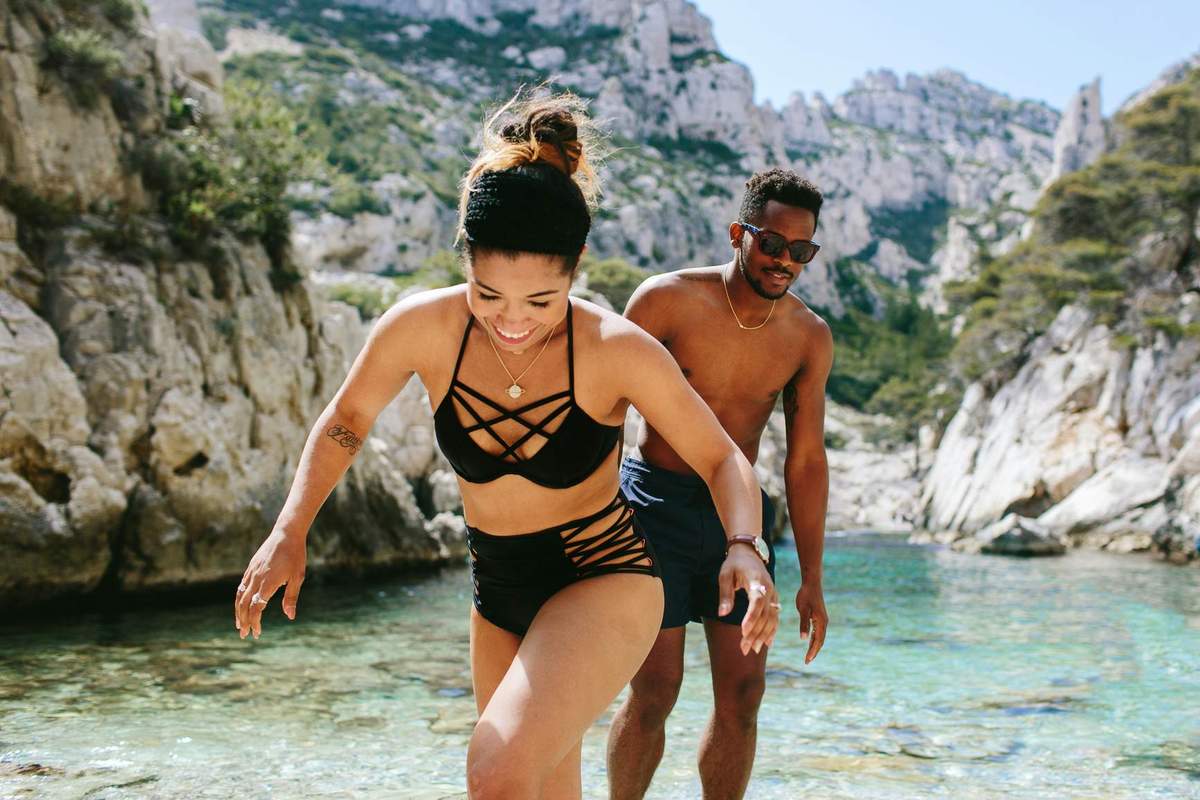
Everything you need to know before booking your Burgundy vacation

Feb 8, 2022 • 8 min read

Semur-en-Auxois is a highlight of Burgundy’s Côte d’Or, accessible by public transportation or by car © Nigel Jarvis / Getty Images
Burgundy or Bordeaux? That’s million-dollar question for any lover of French wine.
Should your fantasy be sipping a glass of Domaine de la Romanée Conti in situ, picnicking between golden vines at harvest time or cruising past Grands Crus vineyards on the back of a vintage Mobylette, Burgundy it is.
Indeed, for those seeking a taste of quintessential France – think drop-dead-gorgeous villages, rolling countryside and sumptuous cuisine – Burgundy beckons. Plan in advance to visit the right vineyard and vaulted cellar tour for you. And once you’re on the ground, under no circumstances should you ask for escargots à la bordelaise when dining out.
Planning your trip to Burgundy
Are you a boater or budget explorer?
Hone in what you hope to get out of your trip to Burgundy and make sure your travel aspirations tally with the season. This bucolic region of vineyards, canals and mustard fields in eastern France has something to offer visitors each month of the year, but each season has its own surprises, challenges and rewards.
Boaters, for example, can only cruise Burgundy’s peaceful waterways between March and November. Sun worshippers and walkers should bear in mind that days remain awfully nippy at either end of the boating season. Festivalgoers can join the Burgundian party in late spring and summer, while winter’s short days are the domain of museum buffs and budget explorers.

If you’re in Burgundy just for the wine, visit in fall
The mellow days of September and October – when pea-green vineyards turn blazing gold, orange, and fiery red – raise the curtain on the vendage. If you’re here to delight your wine-tasting palate, there is no finer time to visit. Many châteaux throw open their vineyards for picnic parties in September.
Scour Burgundy Tourism to research and book wine tours (on foot or by bike, e-bike, scooter, vintage car or Segway), guided tastings and cellar visits.
Decide your lifestyle vibe and book accommodation to match
Whether you’re a city slicker, small-town mouse or rural recluse, there’s a type of Burgundian accommodation that will suit both your personality and your budget.
We’d advise booking hotels, chambres d’hôtes (B&Bs) and countryside gîtes (self-catering farms, cottages and châteaux) at least a month in advance – and farther out for high-season summer stays. The most memorable options mirror the region’s rich history and wine-making traditions. Fall asleep in a medieval turret, wake up to sunlight flooding a surrounding sweep of vineyards at a wine-growing château, or overnight in a centuries-old pilgrim's hostel on the ancient route to Santiago de Compostela.
For urbanites, the sophisticated city of Dijon and regional hub of Beaune make excellent bases.
Sort out wheels: two or four?
Exactly what you’d like to do most during your time in the region will determine how you wish to get to, and around in, Burgundy.
If you’re happy hopping between Dijon, Beaune and other popular towns, then getting around by train – and keeping your carbon footprint low – is easy. Local buses to surrounding villages are an option in some areas, though services are less frequent or non-existent on Sundays and during school holidays. Be sure to cross-check your travel itinerary against real-time bus and train timetables with Mobigo, a region-specific transportation app.
In the insanely handsome but rural Côte d’Or, public transport might get you from Dijon or Beaune as far as Châtillon-sur-Seine or hilltop Semur-en-Auxois. To really savor this world-class wine-growing region, though, you’ll need your own wheels – whether two or four. Green explorers can rent regular bicycles and e-bikes region-wide, and grab a car with Mobigo’s environmentally friendly car-sharing scheme or Dijon-based Divia.
By car, Burgundy is an easy stopover on the way from the English Channel or Paris to the Alps or southern France. The A6 autoroute (highway) traverses the region and offers speedy connections north to Paris and south to Lyon.

Download the right apps
Before hitting the road, download Balades en Bourgogne, the free app from the Côte d’Or tourist board that maps 160 walking, cycling, mountain biking, and driving itineraries around the region.
The other handy app is Atlas Bourgogne, a digital atlas of Burgundy’s vineyards. Included are dozens of handy maps searchable by both town and by climat (the French word for a grape-growing parcel of land in Burgundy, of which the region has 1443 – collectively protected as a Unesco World Heritage site).
Score music festival tickets
Festivals in Burgundy don’t require booking months in advance. Still, to avoid disappointment, buy tickets online for headliner summer festivals like Beaune’s Festival International d’Opéra Baroque et Romantique in July, and the Rencontres Musicales de Vézelay, which fills the tiny hilltop village and its Unesco-prized basilica with song for several days in August.
Reserve canal boats, bike tours and hot-air balloons in advance
Cruising along Burgundy's 1200km (745 miles) of placid waterways by houseboat is pure joy, with peaceful rivers and nature-rich canals fringed with pretty towpaths. Rental companies offer boats from late March to mid-November and require advance booking; early birds often get discounted rates. Try British-run France Afloat or Locaboat Holiday, both about 25km (16 miles) from Auxerre.
Book cycling tours of Burgundy a few months in advance – May, June and September are peak months.
A hot-air balloon flight over Burgundy's handsome mosaic of vineyards, hills and rivers is a breathtaking highlight and is best booked before you leave home – even if you won’t know if the weather will cooperate for the scheduled date of your excursion. Air Escargot, 20km (12 miles) southwest of Beaune, is one of a dozen companies taking to Burgundian skies. Tourist offices in Beaune and Dijon can also help with bookings.
Reserve tables at gastronomic hot spots
Depending on the season, making reservations a few days or even a couple of weeks in advance is vital at Burgundy’s most sought-after dining addresses: boutique hotel–restaurant Aux Terrasses in Tournus, helmed by Michelin-starred chef Jean-Michel Carrette; and Ma Table en Ville in Mâcon.
For unmatched vineyard dining, reserve at contemporary La Millésime in the Côte de Nuits wine-growing area south of Dijon; or at L’O des Vignes, southwest of Mâcon, where Burgundy-born chef Sébastien Chambru pairs seasonal menus with zero-kilometer Pouilly-Fuissé whites.
Etiquette in Burgundy

Eat snails like a Burgundian
Locally reared escargots de Bourgogne (Burgundy snails, or Helix pomatia) – meaty specimens in shiny black shells that come stuffed with garlic and parsley butter before getting baked in the oven – are an irresistible regional specialty. And there is only one correct way to eat them.
Clutch the shell with special snail tongs in one hand, and prize out the earthy gastropod with the other using a twin-tong snail fork. Mopping up the puddle of garlicky oil with bread afterward is perfectly acceptable – and possibly the best bit about eating what any French gourmet will say are the finest snails in France.
Don’t barge in on Mass in churches and abbeys
The region is dotted with historic churches, medieval basilicas and Unesco-prized abbeys of world renown such as Abbaye de Fontenay and Cluny. Many still serve as working churches where Mass is celebrated: some close to visitors during services, but others leave their doors open and allow curious visitors to enter. If a Mass is underway, be sure to behave in a respectful, non-intrusive manner. Remain at the rear of the church, and don’t wander around, talk or make noise.
Churches don’t enforce a strict dress code, but dress respectfully – no short shorts or mini-skirts, with something to cover up bare shoulders.
Take a wine class – and don’t mention Bordeaux!
It’s all very well knowing the difference between a vertical and horizontal tasting. But to understand the curious quirks and minutiae of France’s foremost wine-growing region, refine your palate and really get the most out of cellar visits while in Burgundy, sign up for a wine-tasting class.
Beaune’s hallowed École des Vins de Bourgogne runs a variety of courses, from a three-hour fundamentals class to a three-day wine-taster’s certificate program. If you prefer tasting in situ, consider a half- or full-day tasting session at some of the area’s most famous vineyards with Sensation Vin.
Favor independent eateries – and no giggling over nun’s farts
Most Burgundians take enormous pride in their centuries-old kitchen and culinary traditions. Invest time in learning about the regional cuisine bourguignonne before experiencing some of its traditional dishes. Indeed, there is no finer place on earth to tuck into authentic boeuf bourguignon (slow-cooked beef in red wine) than the region that lends its name to this famous dish.
Other dishes to look out for in traditional bistros and restaurants include oeufs en meurette (eggs poached in red wine), gougères (cheesy choux-pastry puffs, typically served with pre-dinner drinks), and anoudouillette de Mâcon (tripe sausage, grilled and served with mustard). And please, no smirking or giggling, when you come across pets de nonne – literally, “nun’s farts”; actually, deep-fried, deeply delicious donuts doused in sugar or fruit coulis – on the menu.
Never end a meal with a cappuccino
It just isn’t done. When in Burgundy un café (a short sharp espresso) is the only self-respecting option.
Health and safety in Burgundy
Drink the right water
Tap water is safe to drink here, and no meal in France is considered complete without une carafe d’eau (a jug of tap water) on the table. If you prefer bottled mineral water, order une bouteille d’eau plat (still) or une bouteille d’eau gazeuse (sparkling).
Almost every hilltop village and small town has at least one water fountain, sculpted in ornate stone a century or so ago. If the fountain has a sign reading “eau potable” it means the water spouting forth is drinkable.
You might also like:
The best of Burgundy: 15 ways to find French joie de vivre
Why you should follow Burgundy's Route des Grands Crus
Why now is the perfect time to visit Burgundy on a budget















